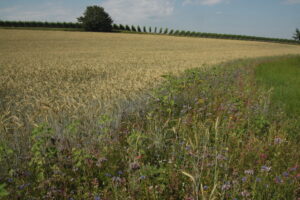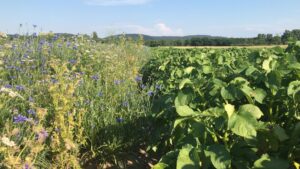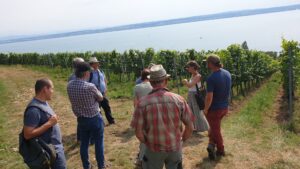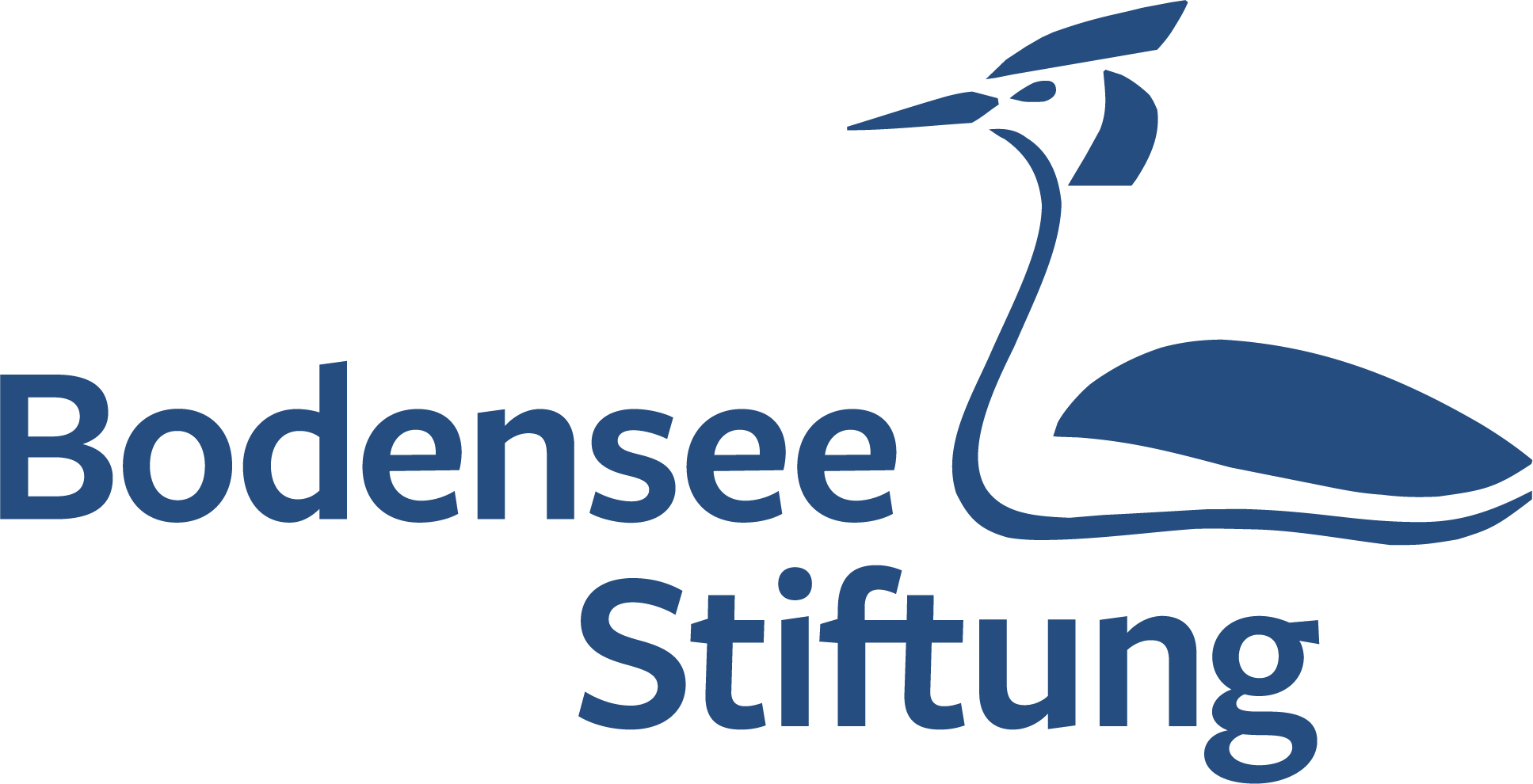The EU LIFE project “Insect-Responsible Sourcing” discussed solutions for more biodiversity at landscape level at an online workshop – examples presented were the “Dutch model” and “KOOPERATIV” in Lower Saxony

Until now, farmers have decided individually whether and which measures to promote biodiversity they want to implement on their farms – for example, flowering areas. In most cases, the focus is on operational rather than nature conservation reasons and the benefits for biodiversity are rather low. Agri-environmental and climate measures (AECM) coordinated across farms can make a considerable difference in terms of impact and reduced costs. As is so often the case, the same applies here: The whole is greater than the sum of its parts. This was made clear in an EU-wide online event that discussed successful cooperative approaches and the associated challenges.
Interest from various European countries
More than 50 participants from various countries of the European Union, authorities, associations, science and politics accepted the invitation of the EU-LIFE project “Insect-Responsible Sourcing Regions” (IRSR). Sarah Westenburg (BoerenNatuur) presented the “Dutch Model”, Dr. Stefan Schüler and Dr. Annika Haß (University of Göttingen) the project “KOOPERATIV”. Christine Kewes (Lake Constance Foundation) and Philipp Uhl (Netzwerk Blühende Landschaft) highlighted approaches in Germany and the IFR project.
No cooperative is successful without trust
The following applies to all of the cooperative approaches presented: farmers are willing to engage with innovative models. However, the following proved to be essential: mutual trust between all actors involved, reliable framework conditions and convincing, meaningful and long-term incentives for farmers. However, adapting and implementing the models presented in different national contexts is a challenge. The discussion of the approaches made this clear.
Cooperation between agriculture, municipalities and companies

Patrick Trötschler, Managing Director of the Lake Constance Foundation and coordinator of the IRSR-project, is certain: “We need the cooperation of various stakeholders to optimize the quality and quantity of important ecosystem services.” Since September 2020, the IRSR project partners have been with various land users – agriculture, municipalities and companies – in seven regions (Allgäu, Lake Constance, Bliesgau, Hohenlohe, Northern Upper Rhine, Wendland and Vinschgau in South Tyrol) to establish “insect-responsible sourcing regions”. Among other things, they tested various measures in around 60 demonstration farms, trained 1,300 people from agriculture, administration and the food industry and developed incentive systems. The “Guidelines for more and better insect promotion at landscape level” will be published shortly.
Making agricultural nature and landscape management work: preconditions for real impact
The Dutch Agricultural Nature and Landscape Management (ANLM) program is internationally recognised for its unique collective approach where groups of farmers and other land owners coordinate and deliver agri-environmental and climate services (AECMs) at a landscape level. Sarah Westenburg, strategic advisor at BoerenNatuur, the umbrella organization of the 40 agricultural collectives in the Netherlands, shared insights into how this model works in practice and reflected critically on its ecological effectiveness, drawing on findings from a recent national evaluation.
While the scheme shows positive effects on habitat quality and species presence, national biodiversity trends remain unchanged. Key challenges include a lack of spatial focus, ecological intensity and long-term commitment. “To move forward, we must stop debating whether measures should be voluntary or mandatory,” Sarah concluded. “Instead, we need to create the right preconditions: sufficient and stable funding, institutional support and a coherent policy framework that enables farmers to deliver real impact.
Ecological, economic and social synergies
In their contribution, Dr. Annika Haß and Dr. Stefan Schüler from the University of Göttingen presented how different actors can be networked with each other through bottom-up structures in order to build a common basis of trust for cooperative action at the landscape level. They also looked at the ecological, economic and social synergies that can arise from cooperative agri-environmental measures. The considerations were based on the example of the KOOPERATIV project, in which numerous local stakeholders – from participating farmers and nature conservation organizations to the mayor – have jointly established 250 hectares of perennial flowering areas at landscape level in the district of Northeim in Lower Saxony. “Local cooperation is the key to making ecological measures much more effective than individual measures,” says Dr. Annika Haß. “The diverse opportunities for participation in the course of events and public relations work as well as the direct contact on site are perceived very positively by the actors involved,” added Dr. Stefan Schüler.
Not an off-the-shelf solution

“There is no one solution for everyone in the EU,” emphasized Christine Kewes, project manager at the Lake Constance Foundation, with a view to the already widely varying agricultural and landscape structures in Germany. Flexibility in funding instruments and implemented measures is urgently needed to make farmers want to implement them.
“It is excellent and absolutely to be welcomed when countries or regions try out new models to bring more diversity and environmental protection to the landscape,” she emphasized, adding that the concepts must be developed for the local conditions (natural resources, agricultural structure, legal requirements, funding pots). “That would really boost our biodiversity. In addition, the framework conditions must be improved, such as simplifying implementation, reducing the risk of sanctions, sufficient remuneration and improved advice.” This must be accompanied by a shift in payments from income support to rewarding the provision of ecosystem services or the common good. “And this also needs to be considered: Higher prices for higher production standards,” says Kewes.
Philipp Uhl (Netzwerk Blühende Landschaft) emphasized that many things are possible in the collaborative implementation of AECM and are already being implemented, but also stressed that this needs to be communicated better and more frequently. This would also help to overcome the dogma that cooperatives are too complex.
Further information:
The “Dutch model”
Farmers in the Netherlands can only implement agri-environmental measures (AUKM) via “Collectieve”. There are 40 such associations that plan, implement and monitor environmental measures on their own responsibility. The associations develop a six-year plan for the conservation goals set by the government in their region, which defines measures with which farmers can contribute to the conservation goals (biodiversity, climate and water protection) adapted to regional conditions and advise farmers on implementation. The “Collectieve” are the final beneficiaries of the agri-environmental support and pay out the subsidies to the farmers. They also monitor the implementation of the measures and their success and communicate this to both the paying agency and the public.
The KOOPERATIV project
In the KOOPERATIV project, the Universities of Göttingen and Rostock and the Landvolk Northeim-Osterode are pursuing an innovative approach in the district of Northeim. Perennial flower strips are implemented as agri-environmental measures on a large scale and cooperatively, i.e. coordinated between several farms. The aim of KOOPERATIV is to record the ecological and economic effects of cooperative flower strips as well as basic governance structures. From an ecological point of view, the effects of the flowering areas on biodiversity and on the agriculturally important ecosystem services of biological pest control and pollination are analyzed. From an economic point of view, the effects of the implementation of flowering areas on individual farms are examined and the governance part of the project is dedicated to the functioning and organization of cooperative measures. The interactions and synergies between the areas of ecology, economy and governance are considered holistically.
Further information on the KOOPERATIV project website
Insect-Responsible Sourcing regions
Funded by the EU, the “LIFE Insect-Responsible Sourcing Regions” project brings together various partners for a common goal: the sustainable protection of insects and biodiversity by and with various land users across large contiguous areas. In seven insect-promoting regions (Allgäu, Lake Constance, Bliesgau, Hohenlohe, Northern Upper Rhine, Wendland and Vinschgau/South Tyrol), measures for insect protection are being tested on demonstration farms. At the same time, farmers, advisors and food companies are being trained and consumers are being made aware of the issue. Other farmers are motivated to develop and implement an action plan to promote insects. Attractive incentives for farmers and (financial) rewards for their commitment from public programs and the food industry also play a role in the project.
Further information on the “Insect-promoting regions” project
A “Guide for more and better insect promotion at landscape level” will soon be published on the website (in German and English).
Conference on the topic: Under the title “More than just Flower Strips – European Conference for more Insect Protection and Biodiversity at Landscape Level”, the final conference of the project will take place on May 20 in Frankfurt am Main. The main topics will be: landscape approach, biodiversity in land management, flowering communities, citizen science & monitoring and policy & incentives. Participation is free of charge. Registration and further information IRSR European Conference – LIFE – Insect-Responsible Sourcing Regions


